A FUTUR TO ANTICIPATE
The number of countries and organizations committing to reaching net-zero emissions over the
coming decades continues to increase.At the European level, we can cite The Green Deal. It aims to guarantee zero emissions by 2050, making Europe the first climate-neutral continent in the world.
In order to help the French government define a sustainable energy transition, the Environment and
Energy Management Agency (ADEME) and RTE, manager of the electricity transmission network in
France, have published two reports on the way to move to a more sustainable energy system by 2050: Transition(s) 2050 (ADEME, November 2021) and Energy futures 2050 (RTE, October 2021).Aware of the urgency of the subject, LCIE Bureau Veritas believes that it is now necessary to evolve
the CODDE® database to meet the challenges of 2050.Ensuring the market launch of sustainable products by 2050 requires anticipating the environmental profile of products. By understanding the significant environmental aspects of products by 2050 today, manufacturers will be able to take the most effective measures.
DATASET OVERVIEW

Electricity and Energy
Based on the scenarios proposed by ADEME and RTE, LCIE Bureau Veritas created Life Cycle Inventory datasets.
Example of CODDE-2857 dataset available in EIME:
- Source: Scenario 1, ADEME: Frugal Generation
- Country: France
- Mix composition: Coal - 0 %, Oil - 0 %, Gas - 0,2 %, Nuclear - 2,5 %; the renewable resources with Biofuels - 0,7 %, Hydro - 15,5 %, Tide - 0 %, Solar PV - 28,8 %, Solar thermal - 0 %, Wind - 51,2 %; and others like Waste 1,3 % and Other sources 0 %
- Carbon footprint: 6.4 g CO2 eq. / MJ
APPLICATION CASE
Using all the datasets in the CODDE®, it is possible to carry out prospective analyses up to 2050.
Here is an application case made with EIME:
- Product: Plastic baby toy
- Country of manufacture: France
- Ecodesign parameters studied: Recycled plastic rate, Recycled cardboard rate, Electric vehicle rate
- Indicator studied: Global warming potential, EF3.1 method

The carbon footprint of toys in 2018 was 698 g CO2 eq.
The prospective analysis conducted with EIME and the CODDE® database shows that it is possible to reduce the product's carbon footprint by up to 86% compared to the reference year (2018).
The ecodesign actions considered are:
- Gradual use of recycled materials in toy and packaging manufacturing. Percentage of recycled materials per year: 0% in 2018; 10% in 2020; 20% in 2022; 100% in 2050.
- Gradual replacement of combustion-engine trucks with electric trucks. Percentage of electric trucks per year: 0% in 2018; 5% in 2020; 10% in 2022; 100% in 2050..
According to the scenarios available in EIME, the carbon footprint of toys in 2050 is estimated at between 94,8 g CO2 eq. (scenario 1, ADEME) and 100 g CO2 eq. (scenario 4, ADEME).
This uncertainty is already being taken into account in the company's environmental strategy, which continues to explore other areas of eco-design.













 SFR/Vodafone – Affichage environnemental
SFR/Vodafone – Affichage environnemental Conforama – Affichage environnemental
Conforama – Affichage environnemental Alstom Transport – Déclarations Environnementales Produit (DEP)
Alstom Transport – Déclarations Environnementales Produit (DEP) Schneider Electric – Product Environmental Profile (PEP)
Schneider Electric – Product Environmental Profile (PEP) Atlantic – Product Environmental Profile (PEP)
Atlantic – Product Environmental Profile (PEP) Arbor – Fiche Déclarations Environnementale et Sanitaire (FDES)
Arbor – Fiche Déclarations Environnementale et Sanitaire (FDES) Neolife – Fiche Déclarations Environnementale et Sanitaire (FDES)
Neolife – Fiche Déclarations Environnementale et Sanitaire (FDES) Atlantic – Communication Environnementale pour le grand public
Atlantic – Communication Environnementale pour le grand public








